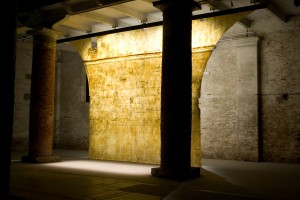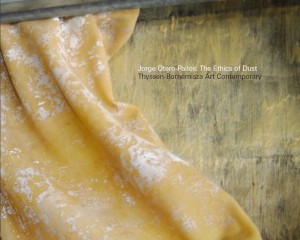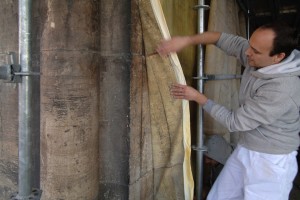In my previous columns in this monthly series, I’ve spoken with a number of practicing conservators to illustrate some of the ways in which we care for contemporary art. But I’ve never engaged directly into a discussion around the ethics of our work. What does it mean to preserve, clean, represent, or repair an artwork, building, monument, or cultural heritage site in the 21st century? What guides our decision-making process and how do we translate this process across different time periods and cultures? These aren’t easy questions.
As a way to consider ethical issues related to conservation, I’ve invited Jorge Otero-Pailos here for a conversation. In addition to being an architect and professor in Columbia University’s Graduate School of Architecture Planning and Preservation, Mr. Otero-Pailos is an artist who installed an artwork in the Doge’s Palace for this year’s Venice Bienale. His project for Venice, The Ethics of Dust, was commissioned by Thyssen-Bornemisza Art Contemporary. Another installation of this project was exhibited at Manifesta 7 in Bolzano:
[youtube:https://www.youtube.com/watch?v=xLkTAJIqzTs]
Richard McCoy: First of all, I really like your work and the complex issues it raises. But because last month I spoke with Glenn Wharton about interviewing living artists, I’d like to start by turning the tables a bit on you. Will you talk about your future plans for this work, and what kinds of parameters have been set into place for its long-term preservation? Or is this work itself ephemeral?
Jorge Otero-Pailos: As conservators know all too well, no work of art lasts forever. The Ethics of Dust is a project to preserve the world’s pollution, a material that I see as emblematic of modernity, but which we know only obliquely through its effects on other objects.
Paradoxically, even though conservation was formed in the effort to deal with the advent of pollution, we really don’t know very much about it politically, culturally, historically, and aesthetically. We also know very little about its own long-term behavior, or how to preserve it. But without it, a major part of our cultural history will be lost.
I’ve attempted to open up this conversation and to focus attention on pollution with this series of installations, in which I save pollution from major monuments. I’m using latex as a way to transfer the pollution from the buildings. Apart from standard directives, I have not set special parameters for its preservation. In what concerns the latex, we benefit from the work that has already been done on the conservation of Eva Hesse’s work. More importantly, regarding the pollution, I hope this work will open up the possibility to take “dust” more seriously and begin experimenting with how to conserve it.

Jorge Otero-Pailos, "The Ethics of Dust: Doge's Palace, Venice, 2009," 53rd Venice Art Bienale, Commissioned by Thyssen-Bornemisza Art Contemporary
RM: The conservator’s role in relation to the preservation and display of cultural heritage is one that I think is often overlooked, or perhaps misunderstood. In the above video, Mark Wigley, Dean of Columbia University’s Graduate School of Architecture Planning and Preservation, frames this very well when he says:
The most radical art today is not an art that rejects history and rejects the kind of layers of history; but actually the most radical art today is about preservation. And so actually the most shocking thing you can do today is protect something.
Before knowing about your project, reading the accompanying catalogue, and watching this video, I had not framed these thoughts this way. How can the way that you addressed this notion of protection be carried back to the practicing conservator, and does it also translate to those of us that work on “fine art,” and not just buildings?
JO-P: You are right to say that the conservator is often overlooked. I would add that being overlooked is what conservators aspire to. The ambition of conservation is to disappear. In a world that is all about presence, that is a very radical position. It is very difficult for the art world to grasp the mode of creativity that is at work in conservation. I find that the art world today is stuck in somewhat old-fashioned conception of creativity as making something new. I’m speaking in very general terms, of course.
But it is true that the art world has great difficulty registering an operation that does not produce something new as creative. The closest it has come is with so-called appropriation art, from Marcel Duchamp down to Richard Prince, but this only skirts the question by shifting the problem onto a different plane: that of the artist’s intentionality.
To conserve, or to protect, is very different from to appropriate. It is a way of leaving things, not taking things.
RM: By choosing what gets protected, we assign value. Those things that do not get protected are valued in a different way. I think The Ethics of Dust demonstrates this in a concrete way. It questions what we value and why. Has the creation and exhibition of this work provided any new insight on how protection influences value?
JO-P: I think of preservation as the organization of attention. If it is true that we live in an attention economy, then preservation certainly influences values, but it does not assign them. Values exist only within relationships of exchange, as a measure of collective attention, or desire. Preservation seems to me to be the result of organized attention, not its origin–although it does also in turn re-organize attention. We rarely choose what gets protected, but we receive things around which social attention has coalesced for one reason or another. These are not necessarily things that everyone likes, or even wants.
Pollution is one of those things that no one wants, yet we recognize that we would not be who we are without it, and that we need it in order to understand ourselves.
As preservationists, we are on the lookout to receive things that need care or protection. What I’m about to say might sound strange, but I think one of the problems with contemporary preservation is that we don’t protect things as much as protect people from things. To preserve something has become a way to make us safe. Perhaps we should speak of safety value. The Ethics of Dust is an attempt to decrease the safety value of pollution, and to bring us closer to what makes us vulnerable.
RM: I’m fascinated by the way you have framed value here. I’m accustomed to working in my principal roles as a conservator who is trying to protect art from physical harm–be it light, temperature, humidity, visitors, dust, etc. But if conservators recognize this idea of safety value, then of course this also pushes back on the artistic process, and then the role that conservators play. It would be helpful to me if artists were more aware of how they wanted their artwork to live its life. How do you see the conservator’s role changing in museums and in relation to architecture?
JO-P: Conservators are becoming participants in the creative process. More and more, they are collaborating with architects and artists in the production of works. It used to be that conservators were operating like consultants, simply trying to solve whatever problems the architects or artists wanted solved. Today, I see the tables turning a bit. Conservators are raising questions about art that are challenging artists to rethink what it means to make art. For instance, conservators used to conserve only works made by artists. Now artists are trying to make art out of the work of conservators.
Let me explain: What happens when we start conserving things that were not made by artists? Even more, what if we conserve things that no one “intended” to make? I’m thinking, as you can probably guess, about conserving pollution. Then something very interesting happens. If it is true that conservators only work on art, then whatever conservators conserve is turned into art. But the conservator does not necessarily become an artist. Art is created without an artist as it were; it is a new sort of unintentional art.
RM: With this in mind, I’d like to ask about what you’re looking at these days. Will you share a photo of something you’ve found important recently?
JO-P: I’m interested in the new picture that was created by conservator Adam Lowe from Veronese’s The Wedding Feast at Cana, which hangs in the Musee du Louvre, thanks to Napoleon’s looting. Lowe has created a copy that reproduces not only the image but also the texture of the canvas.
This facsimile is now installed in the refectory of St. Giorgio Maggiore in Venice, the original space for which the painting was intended. In a sense, the facsimile is more complete than the original that hangs in Paris, because it benefits from the architectural space—without which the original loses much of its meaning.
Here’s a link to the project homepage on Factum Art, and here’s a link to the New York Times article. Finally, here’s a video about the realization of this project:






Pingback: Examining Roles and Investigating Responses; a Conversation with Rebecca Uchill | Art21 Blog
Pingback: “how cold is all history how lifeless all imagery, compared to that which the living nation writes, and the uncorrupted marbe bears! how man pages of doubtful record might we not often spare for a few stones left on upon another! … there are b
Pingback: Millennium People